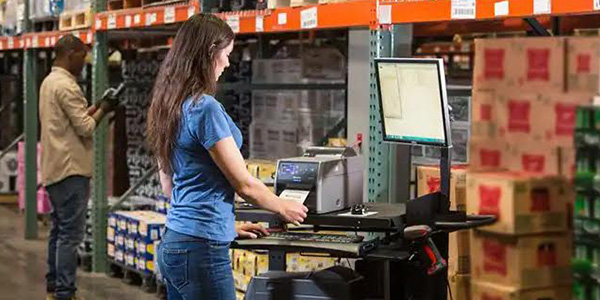
by Chelsea Williams | Jul 27, 2020 | Supply Chain
When news of the coronavirus pandemic first emerged, few could have predicted just how much it would impact the supply chain. This viral outbreak brought a new normal and has resulted in many changes that will last far beyond the pandemic itself.
For many warehouses, production has ramped up to meet the demand for essential supplies. As important as it is to keep the supply chain moving, it is imperative that those on the front lines are kept safe and healthy.
Consider these tips to help maintain the health of your employees and your operation:
1. Use Best Practices to Clean Shared Devices
It’s good to start by creating cleaning and sanitizing protocol for all devices, especially any devices that are shared among employees throughout the day or that pass from one worker to the next between shifts. Scanners, mobile computers, tablets, and other data collection devices are among the most commonly used and should be cleaned and disinfected thoroughly, at regular intervals.
Follow the general best practices for each device. Avoid abrasive cleaners that can damage your devices, and make sure you don’t spray any liquid directly onto the device. Instead, moisten a microfiber cloth with the recommended cleaning solution and gently wipe down your device.
If you aren’t sure what to use on your device, consult the manufacturer’s instructions beforehand. The instructions may vary depending on the device and model. Honeywell provides a handy cleaning and disinfecting guide for all devices.
2. Use Signage to Enhance Communication
It’s a good idea to place placards and signs up that communicate social distancing practices and procedures. You can use peel-and-stick vinyl signs to remind employees to wash their hands and use personal protective equipment like masks and gloves.
Within a retail environment, you want to make sure customers stay an appropriate distance from one another, so peel-and-stick vinyl floor stickers placed six feet apart wherever lines would typically form are a good tool for communicated this.
Finally, it’s wise to maintain a single traffic flow pattern to decrease the number of customers that come face-to-face with one another. This helps combat the potential spread of the virus and helps keep order.
3. Mobilize Your Workforce
Your workers need to maintain social distance from one another while still being able to work freely within your space. To ensure this, you need to have the necessary tools at your disposal.
Equip your workers with mobile devices like tablets and mobile computers that can keep them connected and engaged while maintaining a safe distance. These devices have built-in scanners, cameras, Bluetooth, and more, all of which help you achieve more productivity while simultaneously amplifying connectivity among workers.
Be sure to look for devices with fast charging and a long-lasting battery, as these qualities will be extra important now that there is so much pressure to streamline your operation. This will allow your devices to make it through an entire shift without swapping out batteries or sanitizing between shifts.
4. Implement Mobile Workstations
Implementing mobile workstations is a good way to help maintain social distance while still providing employees with the resources they need to complete their jobs.
Mobile workstations come in flexible configurations that allow them to be used indoors and outdoors and include built-in power sources that last the entire shift. That means you never need to worry about a device dying on you during a shift, and you can effectively eliminate any workflows that require a worker to travel between a shared central location.
5. Transition to Healthcare-Grade Plastics
Not all plastics are made the same. Many won’t stand up to the harsh chemicals and abrasion of abrasive cleaners and multiple cleanings. They will crack and wear down over time.
Healthcare-grade plastics contain antimicrobial additives where available, which help reduce the risk of spreading the virus. These are especially helpful for retailers, who have many different customers coming into contact with these surfaces. By limiting the spread of germs and bacteria, they can benefit from the peace of mind.
Informs offers industry-leading technology designed to help your operation keep up with the ever-increasing demand. Our mobile devices, workstations, and healthcare-grade plastics can help you keep your workers and customers safe while ensuring you stay productive. For more information, contact Informs today.

by Chelsea Williams | Jun 19, 2020 | Warehousing
Despite the fact that over 306 million Americans (95% of the U.S. population) are still affected by stay-at-home orders, that hasn’t stopped them from purchasing products. Online retail has seen massive growth during the coronavirus pandemic. In the U.S., retailers’ online revenue growth is up 68% as of mid-April, surpassing an earlier peak of 49% in early January.
Clearly, COVID-19 has changed retail, possibly permanently. Its initial impact on eCommerce is creating changes to the way we conduct online selling and services in ways nobody imagined.
The pandemic has left the supply chain reeling, but the industry has proven its resilience time and time again. As production ramps up, the warehouses and distribution centers that leverage innovation will be the most successful in meeting modern day demand.
Here are a few tips for achieving breakthrough results:
Mobility, Mobility, Mobility
Shipping used to take an average of three to five days. Those days are long gone. The industry moved swiftly to two-day shipping in order to keep up with giant online retailers, and it will only continue to increase until we see same-day shipping across the board.
With unprecedented speeds like this, the supply chain can’t afford a single second of downtime. Even a single dropped connection or poorly performing application on a handheld device per shift can cost as much as 100 minutes in lost productivity. That is the equivalent of 23% of a worker’s daily shift.
For this reason, it is imperative to increase your enterprise mobility with the right tools and processes, starting with your OS.
While Windows used to be the dominating OS, Android has usurped its position. It now reigns supreme as a mobile operating system, and for good reason. Its open platform gives manufacturers the flexibility to develop an array of devices and form factors that meet the needs of everyday application. Here are some of the latest devices that are helping supply chain operations meet modern day demand:
EDA61K
This rugged handheld mobile computer is ideal for warehouse productivity. It automates and error-proofs workflows in both indoor and outdoor environments like warehouses, distribution centers, and retail backrooms.
What makes this device so special?
Well for one, the battery lasts for two to three shifts on a single charge, which means it will never die on you mid-shift. It also boasts a unique combination of warehouse features, with 4G LTE cellular to help workers stay connected. Plus, it comes with both alphanumeric and numeric keypad options for a better worker experience and easier data entry.
RT10 tablet
This enterprise-grade tablet is built for rapid user adoption, and is designed to minimize the total-cost-of-ownership by giving users the flexibility of using a single device for all use cases.
Its FlexRange scan engine features two complete optical paths. Unlike its competitors, these paths have no moving parts, which enables it to simultaneously capture near- and far-range images without latency.
VM3A vehicle mount computer
This full-sized vehicle-mount computer provides forklift and other vehicle operators with access to data entry applications right at their fingertips, which streamlines workflows and minimizes errors.
The VM3A is available on Android 9 Pie, with upgrades through Android R. It is designed to withstand the rigors of industrial vehicles, and offers a field-replaceable panel to repair touch or keyboard issues without needing to send it in for repair. It also features a Smart Dock, which allows it to be easily docked and removed during vehicle or shift changes.
Honeywell Makes it Easy to Upgrade Android OS
Though the shift from legacy Windows to Android OS is ongoing, Honeywell has remained ahead of the curve, making it easy for warehouse operators to migrate over. In addition, Honeywell even makes it easy to migrate applications from one version of Android to another, via its industry-leading Mobility Edge platform.
Accelerate Deployments
With Mobility Edge, you can deploy faster, easier, and at a lower cost. Warehouses can leverage versatile out-of-the-box capabilities and a rapid provisioning suite. Mobility Edge also expedites development, certification, setup, and training involving multiple form factors at once.
Optimize Business Performance
Powerful, embedded tools across the platform drive faster data capture and secure, enhanced worker communications. This streamlines your entire warehouse for maximum productivity.
Extend Lifecycle
Mobility Edge reduces TCO and minimizes headaches with an enterprise-wide approach to maintenance releases. The hardware is designed to support ongoing upgrades to the operating system through Android 13 (T) and extended support 5 years beyond that, which is longer than any competitor products, and spans across more devices as well.
Strengthen Security
With the unified, dynamic hardware-and-software platform that Mobility Edge provides, Honeywell has taken an agile approach to enabling enterprise IT to deliver better mobile solutions across your business.
Making Sense of the Data to Drive Better Decisions
The right devices, platforms, and operating systems won’t be enough to completely improve warehouse productivity without the right analytics software. Honeywell’s Operational Intelligence analytics software includes four modules that work together to help IT teams manage and optimize assets across all locations, throughout the asset lifecycle.
With Operational Intelligence, your IT resources gain performance analytics to help predict issues with device health and maintenance even before they occur. It does this by tracking device and application usage, gathering data to help analyze worker performance and workflow efficiencies. With this, you can easily identify any bottlenecks and solve issues that are diminishing warehouse productivity.
Boosting productivity is essential now and will only become more essential in the future as we move towards same-day shipping. To truly optimize your workflow, it is necessary to have the right tools in place. Informs, Inc. offers a wide range of devices designed for this purpose as well as the expertise to implement them. For more information, contact the experts at Informs.

by Chelsea Williams | Apr 27, 2020 | Retail, Uncategorized
Back in May of 2016, the FDA published new guidelines for the new Nutrition Facts label. The 2020 nutrition label guidelines are updated to reflect additional requirements for what information must be included on each label. Nutrition labels are a critical component of packaging for food products, and these guidelines must not be ignored. Customers rely on these labels to inform them about what they are putting into their bodies so they can track their nutrients and stay healthy.
Companies that exceed $10 million in revenue had to update their labels by Jan 1 of 2020. However, companies below that revenue mark, or single supply manufacturers of ingredients like sugar and honey have until January of 2021. It’s critical that you ensure your labels are updated to reflect the new changes before the deadline so that your operation can stay compliant.
Here’s what you need to know:
Out with the Old and In with the New: A Refreshed Design
The iconic look of the label remains, but important updates were made to ensure consumers have quick access to the information they need to make informed decisions. The formatting has been updated with larger print and a bold typeface.
Additionally, manufacturers must declare the actual amount of different macro and micronutrients, as well as the percent daily value of vitamin D, calcium, iron, and potassium. Another major change involves added sugars, which is an entirely new category that has been created. Added sugars can include syrups, honey, fruit juices, and other forms of sugar.
Updated Information about Nutrition Science
Beyond the actual nutrients on the label, the FDA has made updates to how these nutrients are listed, and the amounts of each that an item may contain. The percent daily value of any vitamin or mineral listed in the nutrition facts may not exceed 100%.
Vitamins A and C have been removed from the format, since deficiency of these is very rare. However, required ingredients like calcium, iron, potassium, and sodium must now include the updated daily values. The daily value for sodium has decreased from 2,400 mg per day to 2,300 mg.
The percent daily value footnote itself has been updated to be easier to understand, with a better explanation of what it means. The new footnote now reads:
*The % Daily Value tells you how much a nutrient in a serving of food contributes to a daily diet. 2,000 calories a day is used for general nutrition advice.
Updated Serving Sizes and Labeling Requirements
At the top of the label, the most apparent change is to the calorie line. With the updated format, the calories are in a larger font than the rest of the information and are displayed using a bold typeface to make it easier for consumers to read at a glance. The calories from fat are no longer required on the calorie line, to draw more attention to the type of fat included, rather than the calories.
The serving size has also been updated to be more visible, as well as the servings per container. There had been some discrepancies between the serving sizes listed on the nutrition labels, and the actual amount that is normally consumed on average today in the US. With the updated nutrition label guidelines, consumers can now better track and understand what they are putting into their bodies, and are more aware of the recommended nutritional guidelines they should aim to hit.
Contact Informs to Get Your Updated Labels Created and Printed
Updating your labels is never a fun task but Informs can help make it easier. We don’t just offer industry-leading printers and labels for both thermal and color printing, we also offer label design software for businesses looking to design their new nutrition labels, and preprint services for those looking to outsource the print job.
By pairing the latest and most innovative labeling solutions with our industry expertise, you can create visible, easy-to-read labels that keep you in compliance with FDA guidelines and keep customers better informed. For more information on the updated 2020 nutrition label changes, or how our cutting-edge labeling solutions can help your operation boost productivity while remaining compliant, contact an expert at Informs today!

by Chelsea Williams | Apr 20, 2020 | Manufacturing, Printing, Warehousing
With high competition and increased demands for speed and efficiency, warehouse operators must always be on the lookout for ways to improve productivity. Mobile cart workstations are built for just that. The ability to take your work process mobile has many time-saving and cost-saving benefits, especially for those in warehouses and factory settings, where efficiency depends on mobility.
Here are five reasons your warehouse may want to look into mobile cart workstations:
Accelerate Data Capture and Inventory Handling
While it may not seem like it, the ability to keep employees closer to the point of activity saves significant time. True, you may shave only a few seconds off the time it takes for an employee to walk back and forth to a fixed station, but that adds up over time.
By scanning and printing right at the source, you can increase quality, accuracy, and speed of data capture. When processes are more efficient, your workers can have more time to do their jobs thoroughly and double-check the quality of their work, as well. Having a mobile computer, printer, and scanner station allows employees to take their work with them, saving on both time and labor costs by equipping workers to work more productively.
Empower Your Employees Without Limiting Capabilities or Compromising Accuracy
A mobile cart workstation allows you to improve efficiency in many ways. In addition to computers, printers, and scanners, a mobile cart offers workers access to critical business systems. They can have instant access to their WMS system, ERP, and other network applications, no matter where they are in the facility.
Mobile carts empower workers to perform daily transactions and tasks without limiting their capabilities or compromising accuracy. They’ll no longer have to spend cumulative hours walking back and forth between the receiving and storage areas just to input data and print labels. They can also eliminate bottlenecks in the inventory process, helping to streamline employee workflow and free up more space in the warehouse by doing away with fixed workstations.
Improve the Return Process
Returns are often a necessary evil. The different ways each returned product must be processed tends to place a burden on warehouse operations and slow down productivity. With a mobile workstation, the workers responsible for processing returns will have the necessary information they need right at their fingertips. Mobile carts offer access to inventory, accounting, data capture, and order system information so they can quickly determine the ultimate disposition of the returned merchandise.
With the ability to have updates to data reflected in the inventory system in real time, workers can fulfill new orders, while customers can be credited faster. This not only improves productivity within your workflow, but it increases customer satisfaction.
Eliminate Extension Cords and Power Strips
Large industrial extension cords are not just merely an eyesore—they’re hazardous to the health and safety of your workers and equipment. A mess of extension cords makes your warehouse floor look messy and unprofessional, and it poses a risk to busy employees that can easily trip and fall. Any assets they are carrying may be damaged, but more importantly, your employees themselves may be injured.
A mobile computer station solves this problem by utilizing a rechargeable power pack, which eliminates the need for a wired connection to the mains. The batteries on mobile cart workstations are built last a full shift. Some even last up to 15 hours. Essential components like monitors and keyboards are built into the mobile computer station, so there are no wires needed to connect them together.
A Happy Employee is an Efficient Employee
Employees can quickly become demoralized if they realize they are working in an inefficient environment. Workers want to know you value their time, and don’t want to waste their hard labor walking back and forth unnecessarily from the point of data capture to the stationary computer.
Mobile workstations eliminate the need for trips across the warehouse, and enable workers to carry less equipment with them back and forth. By providing your employees with a mobile cart, you are making their jobs more comfortable and untethering them to stationary workstations, allowing them to increase productivity and output.
Conclusion
The times are changing, and warehouses now must embrace new ways to improve mobility and streamline workflow. Over the course of the week, mobile carts can eliminate hours of time spent on unnecessary trips, greatly improving speed and efficiency all around.
Informs, Inc. offers these ergonomically-designed mobile computer stations for enterprises looking to increase productivity and improve quality of life for workers on the job. By investing in mobile carts, you can equip your employees to speed up processes, and set yourself up to stay competitive and profitable in your industry. For more information on our mobile cart workstations, contact Informs today.

by Chelsea Williams | Apr 6, 2020 | Uncategorized
Faster and more reliable than predecessors, 5G networks have the potential to revolutionize enterprise mobility beyond what has been previously considered possible. With future technology advancements, users will soon come to rely on 5G networks to power their operations efficiently and increase mobility within their enterprises.
Though 5G devices aren’t used widely throughout the industry yet, they will soon shape the future of enterprise mobility. Here’s how:
5G will Boost Enterprise Mobility to the Next Level
Employee flexibility
Now more than ever, more enterprises are allowing employees to work remotely, relying on wireless connections to communicate. This need for increased connectivity also applies to workers out in the field, who must rely on a network connection to complete tasks. 5G networks allow for increased speed and connectivity, equipping employees to stay more engaged while on the clock, regardless of their location.
Increased productivity
Devices that still rely on 3G networks are lagging far behind those built on 4G networks. With 5G on the horizon, users operating on outdated devices won’t be able to compete. 5G offers 20 gigabytes per second (gbps) of data transfer capabilities compared to the 21.6 megabytes per second (mbps) of 3G and 1 gbps of 4G.
Smoother operations
With 5G, connectivity is increased, which means that as enterprises adopt these networks, apps will run faster and will encounter fewer issues. This leads to faster processes, greater transfer of data, deeper visibility, increased mobility, and more. All these benefits combine to help enterprises achieve a streamlined, cohesive, and productive operation.
Cloud will Become the Foundation for Enterprises
More than ever, companies are switching from on-premises to cloud-based systems, since they make it easier to access data from anywhere with a device on the network. Cloud networks allow for enhanced communication between devices and across systems, and 5G will give companies fast access to a range of cloud-based servers.
AR and VR Technologies will Expand Engagement
Increased data speed will open the pathways for better streaming. Resource-heavy streaming will be easier to access and leverage in order to increase engagement. This includes technologies like augmented reality (AR), virtual reality (VR) and video conferencing, some of which have been adopted early and are becoming more prominent in field services.
Honeywell, Intel, Ericsson, and the development of 5G Products
While 5G is still relatively new to the industry, innovators like Honeywell, Intel, and Ericsson have been collaborating to develop new devices that leverage 5G connectivity and system capabilities. Now that the internet-of-things (IoT) has become more prevalent within the supply chain, the better connectivity of 5G means that devices no longer need to compete as much for data during mission-critical applications.
Though there are still significant challenges, the future of this technology is bright, and 5G system capabilities such as network slicing and distributing edge computing can greatly increase efficiencies within the warehouse. With this, operators can prioritize device traffic, ensuring that mission-critical applications take priority without decreasing productivity elsewhere.
5G is a Ways Off, but Not For Long:
5G has only been around for a short while, and it is something industry experts are still monitoring for now. While it could potentially lead to disruptions in the industry and increased competition, 4G is still the most reliable and widely used network.
Those that are still operating on 3G are encouraged to upgrade to 4G at this time, as 5G is still on the horizon, but competition is already increasing, and it will be difficult for enterprises to keep up if they are depending on outdated systems and processes.
While it’s tempting to want to hold off on upgrading until 5G is here and easily available, you risk falling too far behind the competition to make up for lost time. It’s better to upgrade to 4G now and meet the already-increasing industry demands of today than wait for 5G to be ready.
Informs offers a wide variety of mission-critical enterprise mobility solutions designed to help you achieve maximum productivity within your operation. For more information on enterprise mobility, or to view our products and services, contact Informs today.






Recent Comments